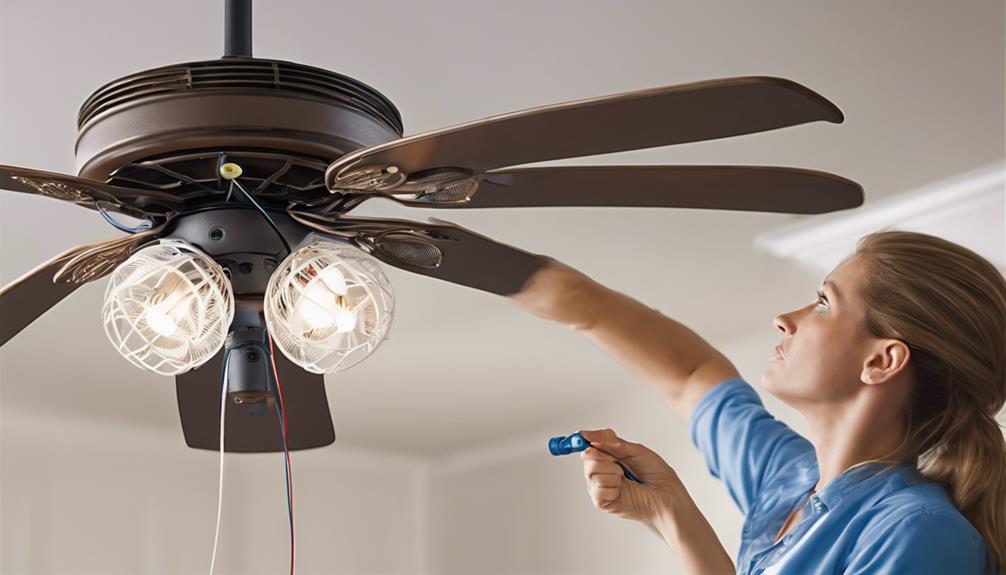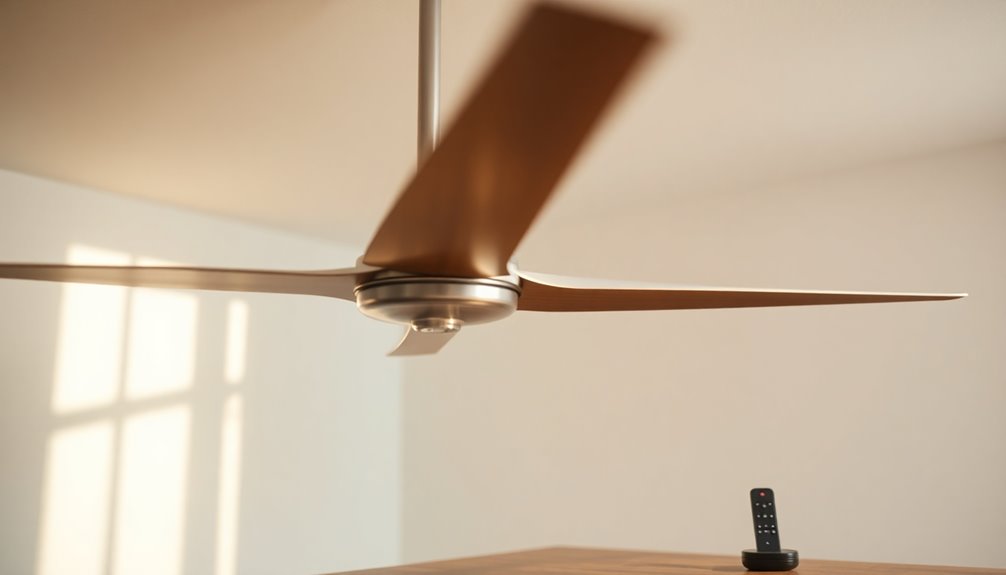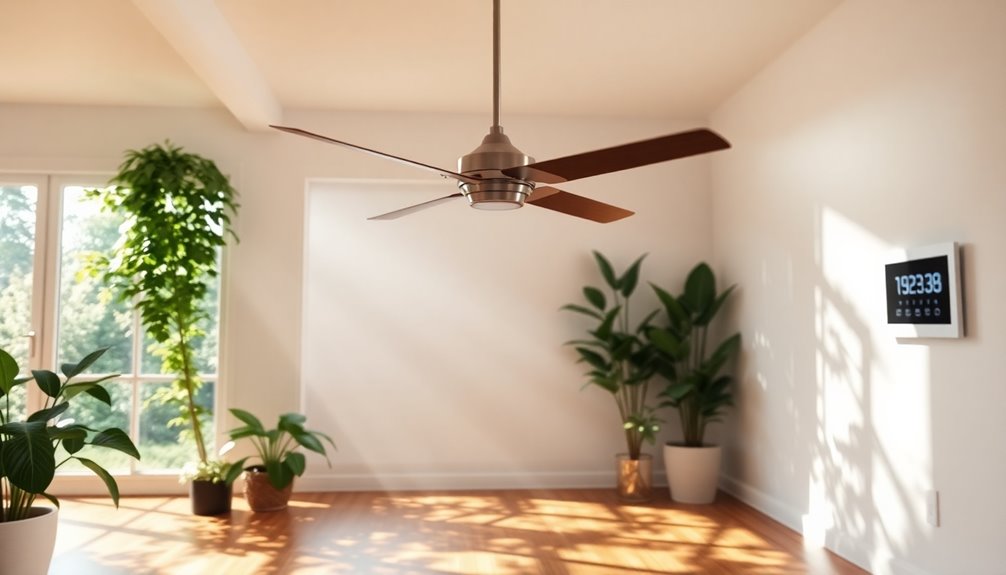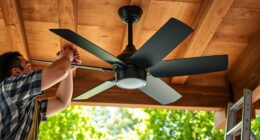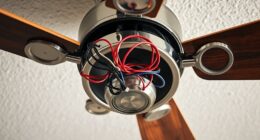A ceiling fan typically uses between 0.2 and 6 amps, depending on its size and type. Standard fans around 1300mm usually draw between 0.7 and 1.2 amps, while energy-efficient ENERGY STAR® models consume about 0.4 amps. Smaller fans for tight spaces may only use 0.2 to 0.6 amps. Keep in mind that startup amps can surge to 2 or 3 times the normal running amps, so be aware of that when planning. Understanding these details can help you manage your energy costs better, and there's still more to discover about maximizing fan efficiency and lowering bills!
Key Takeaways
- Typical ceiling fan amperage ranges from 0.2 to 6 amps, depending on the model and size.
- Standard 1300mm fans usually draw between 0.7 to 1.2 amps during operation.
- ENERGY STAR® fans operate efficiently at approximately 0.4 amps, consuming less energy.
- Smaller fans, like 900mm models, consume less power, averaging 0.2 to 0.6 amps.
- Running amps can surge to 2 to 3 times normal levels during startup.
Key Takeaways

When considering how many amps a ceiling fan uses, it's essential to know that these appliances typically consume between 0.2 to 6 amps, depending on various factors.
The size and design of the fan play a noteworthy role in its amperage consumption. For instance, a standard 1300mm ceiling fan generally draws between 0.7 to 1.2 amps during regular operation.
If you're looking at low-profile or bladeless models, you'll find they operate at lower amperage, around 0.3 to 0.5 amps.
It's important to remember that during startup, your ceiling fan can draw considerably more amps—often 2 to 3 times its normal running amperage. This spike can be momentarily concerning but is a normal part of fan operation.
If you're considering energy efficiency, look for ENERGY STAR® ceiling fans, which are about 40% more efficient than conventional models, consuming around 0.4 amps.
Understanding these variations in amps will help you make informed decisions about your ceiling fan usage and its impact on your energy bills.
Amps, Volts, and Watts Explained

When you're looking at how a ceiling fan operates, it's essential to understand the relationship between amps, volts, and watts.
Amps measure the current flow, volts indicate the electrical pressure, and watts show how much energy is being used.
Understanding Electrical Units
Understanding electrical units like amps, volts, and watts is essential for anyone looking to manage their home's energy consumption effectively. Amps measure the current flow in an electrical circuit, indicating how much electricity is being used at any given moment.
When you look at your ceiling fan, knowing its amp draw helps you understand its energy use. The relationship between amps, volts, and watts can be summed up with the formula: Amps = Watts ÷ Volts. This means if you know the wattage and voltage of your ceiling fan, you can easily calculate its amp usage.
For example, if a fan consumes 70 watts at 120 volts, it draws approximately 0.58 amps. Typically, ceiling fans use between 0.2 to 6 amps, with most residential fans averaging around 1.5 amps.
Understanding voltage is also vital since it represents the electrical pressure pushing the current through the circuit. This knowledge is essential not just for ceiling fans, but for other appliances too.
Power Consumption Basics
To grasp how your ceiling fan operates efficiently, it's important to break down the relationship between amps, volts, and watts. Amps measure the current flow in a circuit, and when it comes to ceiling fans, higher amperage means increased power consumption.
You can calculate the amps used by your fan with the formula: Amps = Watts ÷ Volts. This lets you determine the amperage based on the wattage of your ceiling fan and the voltage of your electrical supply.
Typically, standard ceiling fan amperage ranges from 0.2 to 6 amps, depending on factors like size, blade count, and energy efficiency. For instance, a 1200mm three-blade ceiling fan usually consumes between 0.3 to 0.4 amps, while larger models may pull higher amperage.
Understanding these electrical units is essential not just for your knowledge but also for ensuring safe operation. You want to make sure your ceiling fan complies with your circuit's capacity to avoid any electrical issues.
Amperage by Ceiling Fan Type

When choosing a ceiling fan, it's important to contemplate how different types affect energy consumption.
Standard fans draw more amps than energy-efficient models like ENERGY STAR® fans, which can help lower your bills.
Additionally, the size of the fan plays a significant role, with larger models generally using more amperage than smaller ones.
Energy Consumption Comparison
Ceiling fans vary widely in energy consumption, making it essential to compare their amperage based on type.
Standard ceiling fans usually consume between 0.6 to 1.2 amps, with 1300mm fans typically drawing around 0.7 to 1.2 amps. If you're looking for energy efficiency, consider low-profile or bladeless fans, which use only about 0.3 to 0.5 amps due to their lower wattage of 40-60 watts.
For even better efficiency, ENERGY STAR® certified fans operate at about 0.4 amps, showing a 40% improvement compared to conventional models.
If you're interested in dual-motor fans, be aware that their consumption ranges from 0.4 to 1.2 amps depending on the wattage for each motor, which can be between 50 to 150 watts.
Smart ceiling fans are another option. They're designed for efficiency and consume around 0.2 to 0.3 amps while offering advanced features like remote control and temperature sensing. Additionally, using energy-efficient technology in your home can significantly reduce overall energy consumption and costs.
Fan Size Impact
The size of a ceiling fan greatly influences its amperage consumption, which is essential for selecting the right model for your space. Understanding how different fan sizes impact amperage helps you make informed decisions based on your needs.
- 900mm fans: Typically draw 0.2 to 0.6 amps, ideal for smaller rooms.
- 1200mm three-blade fans: Generally use 0.3 to 0.4 amps, balancing efficiency and performance.
- 1300mm fans: Consume between 0.7 to 1.2 amps, perfect for larger areas needing higher airflow.
- Bladeless or low-profile fans: Operate at 0.3 to 0.5 amps, combining modern design with energy efficiency.
- Dual-motor fans: Offer enhanced performance with amperage ranging from 0.4 to 1.2 amps, depending on wattage and fan speed settings.
Startup Amps vs. Running Amps

Understanding the difference between startup amps and running amps is essential for anyone using a ceiling fan. When you first turn on your fan, it draws more power than usual, a phenomenon known as startup amps. This initial surge can be 2-3 times higher than the fan's regular operating wattage.
For example, if your ceiling fan has a running wattage of 70W, it might draw around 1.25 amps at startup, reaching approximately 150W during that brief moment.
Typically, the running amps for most ceiling fans range from 0.2 to 1.2 amps, depending on their size and type. However, startup amps can vary greatly.
This difference is vital to understand because your power supply needs to handle that initial load without tripping breakers. If your electrical circuit isn't equipped to manage the surge of startup amps, you could face interruptions or damage.
Calculating Your Ceiling Fan Amps

Calculating the amps your ceiling fan uses is straightforward and can help you guarantee your electrical system is up to the task. To determine the amperage, you can use the formula: Amps = Watts ÷ Volts. Typically, ceiling fans range from 0.2 to 6 amps, depending on their size and design.
Here are a few key points to take into account:
- Fan Size: A 1200mm three-blade fan usually operates at about 0.3 to 0.4 amps, consuming 35-50 watts.
- Larger Models: A 1300mm fan may draw between 0.7 to 1.2 amps, using 78-140 watts.
- Startup Amps: Remember, fans often require 2-3 times more amperage at startup than during regular operation.
- Check the Nameplate: Always refer to the fan's nameplate rating for the most accurate information on amps specific to your model.
- Voltage Consideration: Most household fans operate on 120 volts, so this will influence your calculations.
Tips for Reducing Electricity Costs

Reducing electricity costs while using your ceiling fan is easier than you might think. One effective strategy is to raise your thermostat by 4°F when you run your air conditioning. Ceiling fans help distribute cool air more efficiently, allowing you to enjoy comfort without cranking up the AC.
Consider installing ENERGY STAR® ceiling fans, which consume only 48-52 watts—about 40% more efficient than standard models. This efficiency translates to lower electricity bills. Pairing ceiling fans with your AC lets you raise the thermostat setting, potentially saving you up to 20% on cooling costs. Additionally, using ceiling fans in combination with heat pumps can further enhance energy efficiency and reduce overall consumption. This is because proper maintenance of heat pumps can significantly improve their performance and energy use.
Don't overlook regular maintenance, either. Cleaning your ceiling fan blades can greatly improve efficiency. Dust buildup can hinder airflow, making the fan work harder and consume more energy.
Additionally, opting for larger blade fans can enhance cooling efficiency, allowing you to run the fan on lower speeds, conserving even more energy. Implementing proper insulation can further reduce the overall energy consumption of your home, maximizing the effectiveness of your ceiling fan.
Frequently Asked Questions
Can You Run a Ceiling Fan on a 15 Amp Circuit?
Yes, you can run a ceiling fan on a 15 amp circuit.
In fact, a standard ceiling fan typically draws between 0.2 to 6 amps, making it safe for this setup.
With a 15 amp circuit, you've got enough capacity to run multiple fans and lights, as long as you keep the total amperage below 12 amps.
Always remember to follow local electrical codes and consult a licensed electrician for any complex installations.
How Many Fans Can You Put on a 15 Amp Breaker?
You might think you can fill a 15 amp breaker with as many ceiling fans as you want, but that's not entirely safe.
In reality, you can connect up to 24 fans if they each draw 0.5 amps. However, keep in mind that any additional devices will reduce your fan count.
Always check the overall wattage and adhere to local codes. Consulting a licensed electrician is a smart move for safety.
How Many Ceiling Fans Can You Run on One Breaker?
You can run a varying number of ceiling fans on one breaker, depending on the wattage of each fan and the circuit's amperage.
For a standard 15-amp circuit, you might manage around 12 fans if they each consume about 60 watts.
If the fans use more energy, like 100 watts, you'll need to limit yourself to about 8.
Always factor in other devices to avoid overloading the circuit.
How Many Amps Does a Normal Ceiling Fan Draw?
When it comes to energy usage, a ceiling fan's draw is like a whisper in a quiet room—subtle yet impactful.
Most residential fans typically pull between 0.2 to 6 amps, with the average around 1.5 amps.
Standard three-blade models usually consume about 0.3 to 0.4 amps, while larger ones can go up to 1.2 amps.
If you're looking for efficiency, ENERGY STAR® fans often use only around 0.4 amps.
Conclusion
In summary, understanding how many amps your ceiling fan uses can help you manage your energy costs effectively. You might think it's too complicated to calculate, but it's simpler than you'd expect. By knowing the amps, volts, and watts, you can make informed decisions about your fan usage. Plus, implementing a few energy-saving tips can lead to noticeable savings on your electricity bill. So, don't hesitate—take control of your ceiling fan's energy consumption today!


